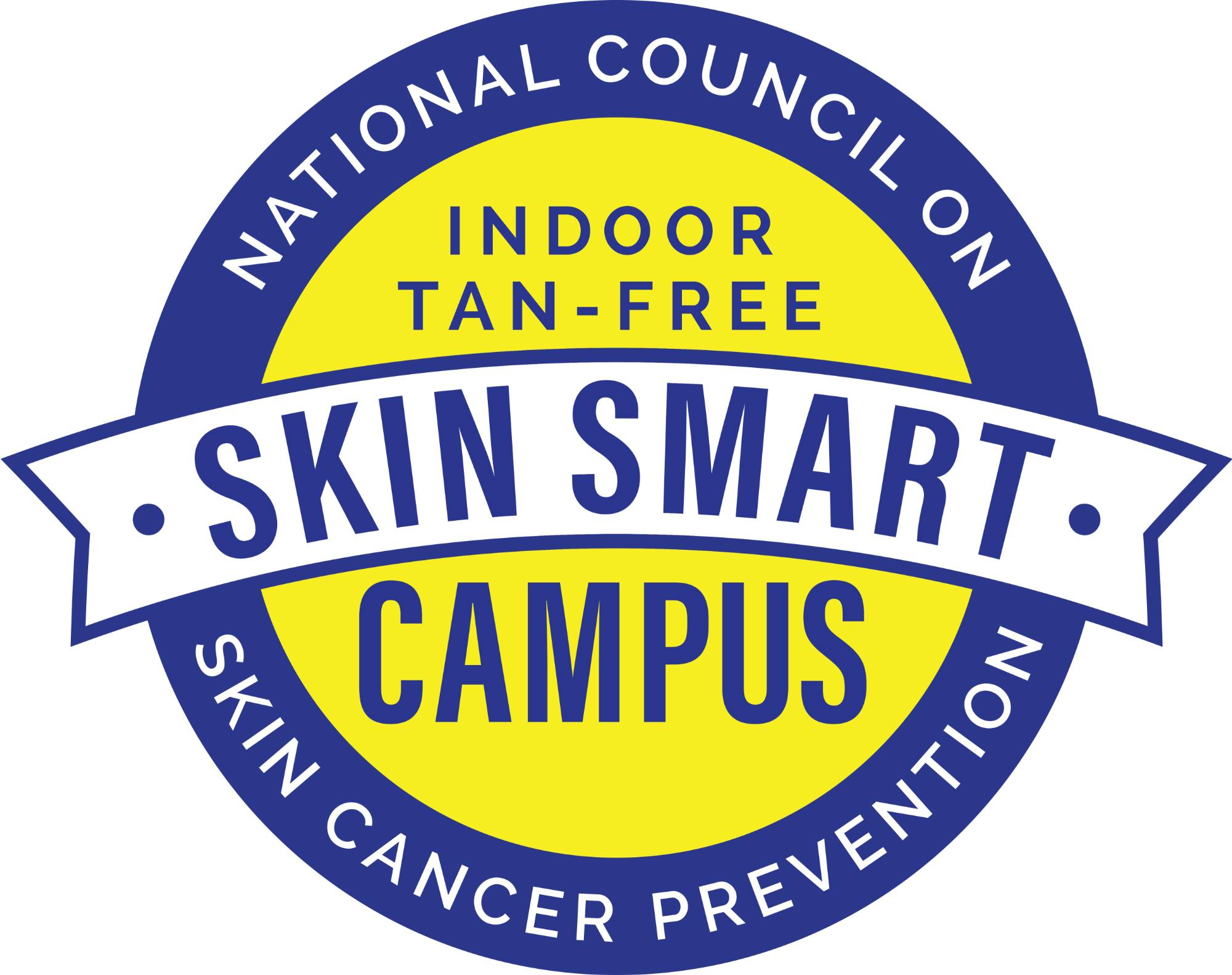Skin Smart Campus
Grand Valley State University has been recognized as a Skin Smart Campus by The National Council on Skin Cancer Prevention. Ensuring the well-being of our students, we are providing a safe and healthy learning and living environment on and off campus, pledging to keep indoor tanning devices off our campus and our affiliated buildings. We also promote skin cancer prevention policies and education.
The Indoor Tan-Free Skin Smart Campus Initiative is sponsored by the National Council on Skin Cancer Prevention in response to the 2014 U.S. Surgeon General’s Call to Action to Prevent Skin Cancer which concluded that there is a strong association between increased risk of skin cancer and indoor tanning use. Ultraviolet (UV) radiation exposure from indoor tanning is completely avoidable which allows for interventions to help reduce skin-cancer related illness and deaths. Numerous studies have found that skin cancer is the most common type of cancer in the United States, with melanoma as one of the most common cancers diagnosed among young adults. According to The International Agency for Research on Cancer Working Group, the use of indoor tanning facilities before the age of 35 increases the risk for melanoma by 75 percent.
Learn more at skinsmartcampus.org.
Contrary to Popular Belief...
Fact: Any change in your normal skin color is a sign of skin damage.
Fact: Wearing sunscreen and protecting yourself from the sun is important no matter the weather.
Fact: Sunscreen protection may be lowered if you do not apply enough (an ounce worth for your body, and a tablespoon worth for your face), do not reapply or do not apply consistently.
Fact: Skin cancer is the most common type of cancer in the United States.
Fact: No one is immune to skin cancer. Some people may have more risk factors than others, but anyone can develop it.
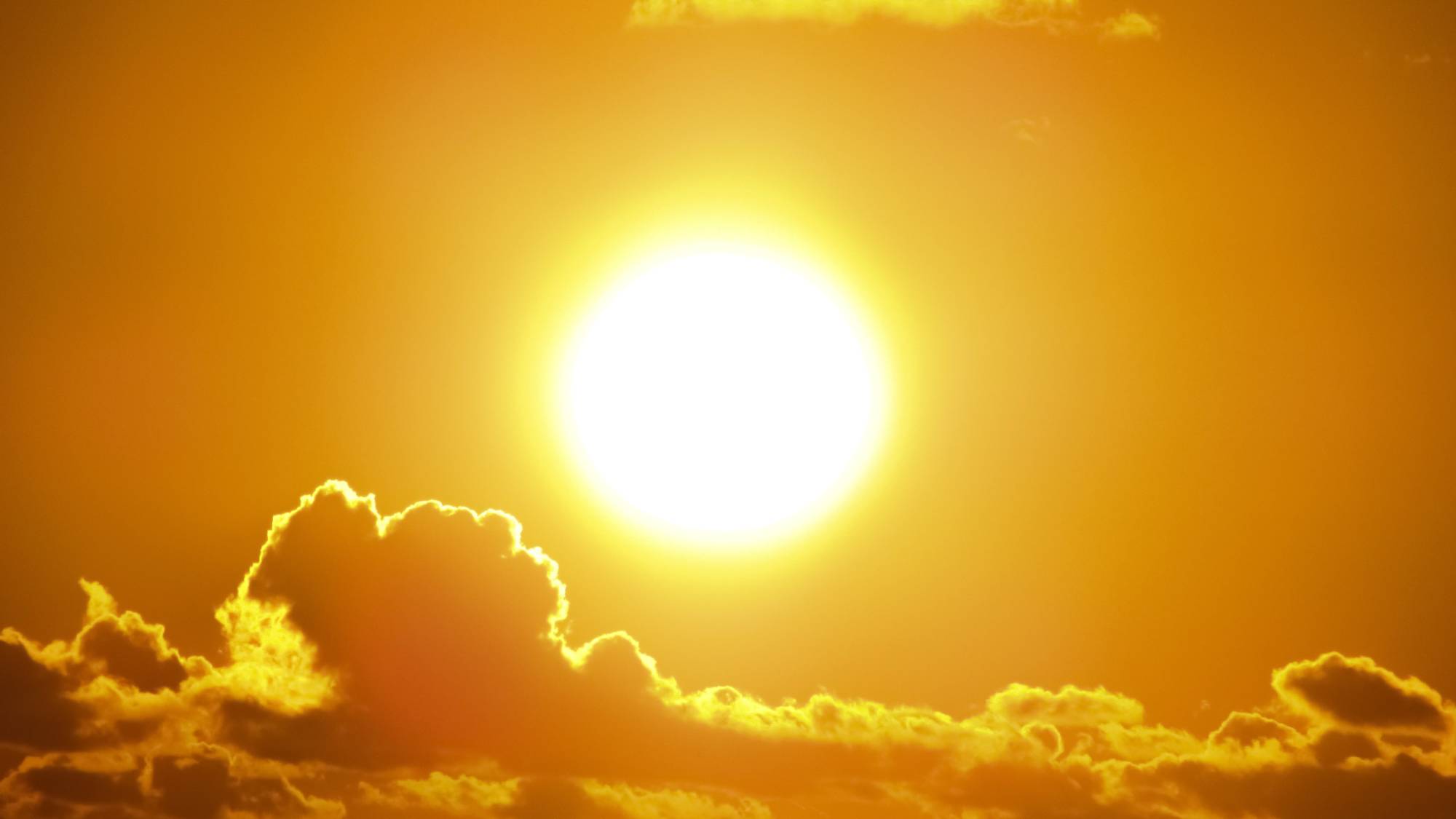
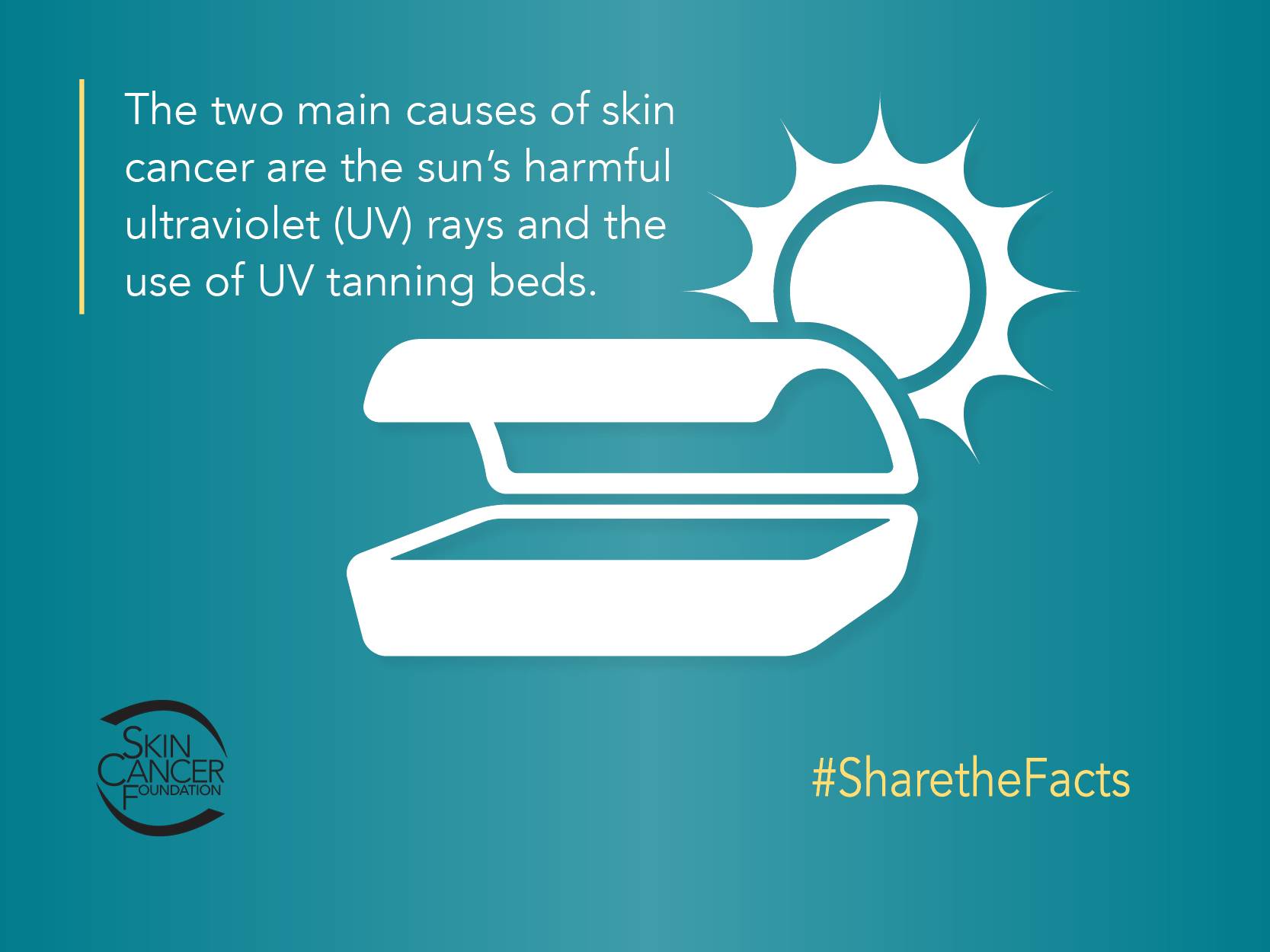
UV rays from the sun and from tanning beds are the top two causes of skin cancer.
Fast Facts
- Top two most common skin cancers: basal cell carcinoma and squamous cell carcinoma
- These have a high rate of curability, but it can be costly and cause skin deformations.
- Third most common skin cancer: melanoma
- Can be deadly, but if caught early the risk of death decreases significantly.
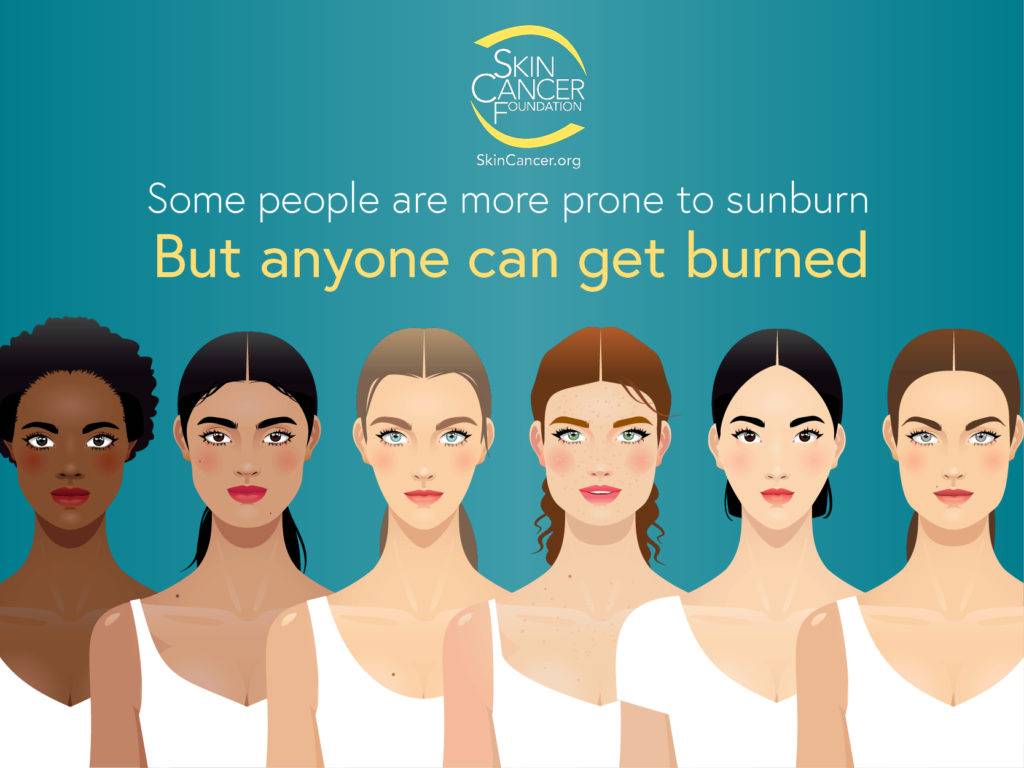
General Risk Factors
- Light skin, or skin that burns, freckles, or reddens easily; but skin of all colors can get skin cancer
- Having a large number of moles
- Personal or family history of skin cancer
- History of sun exposure; skin damage is cumulative!
- History of sunburns, especially in early life
- History of indoor tanning:
- the average tanning bed gives off 2 to 10 times more UVA radiation than the sun
- using tanning beds before the age of 35 increases a person's risk for developing melanoma by 75%
Skin of Color
Skin of Color – includes people of African, Asian, Latino, Mediterranean, Middle Eastern, and Native American descent
- Even if you have a darker skin tone, always tan or rarely burn, you can still get skin cancer
- Skin cancer is often diagnosed later in people of color, making it harder to treat
- Melanoma in people of color most often occurs on the palms of the hands, soles of the feet, under the nail (subungual) and in the nail areas
- No matter your skin tone, UV radiation can lead to skin damage, premature aging, and hyperpigmentation. Protecting your skin is important!
Prevention Tips
The majority of skin cancers are caused by exposure to ultraviolet (UV) light and can be prevented with sun safety practices.
- Find shade under a dense tree canopy, shade sail, or pavilion
- Carry a sun umbrella for personal shade
- Use a pop-up UV shelter when at the beach or park
- Whenever possible, stay out of the sun from 10 AM - 4 PM when UV radiation is the strongest
- Broad spectrum UVA and UVB, SPF 30 or higher
- Reapplication is necessary every 2 hours and after swimming, sweating, or toweling off
- Most people do not put on enough sunscreen–aim for one ounce, which is about a palmful
- Long sleeves/pants with a dense weave or built in UPF
- Wide-brimmed hat
- Closed-toe shoes and socks that cover the ankle
- Choose sunglasses with a UV protective coating
- Wearing sunglasses helps protect the delicate skin around our eyes
- UV rays can also increase risk of cataracts & macular degeneration–it's important to protect your eyes!
Check the UV index before you head out
You can find the current UV index for your area on most weather apps.
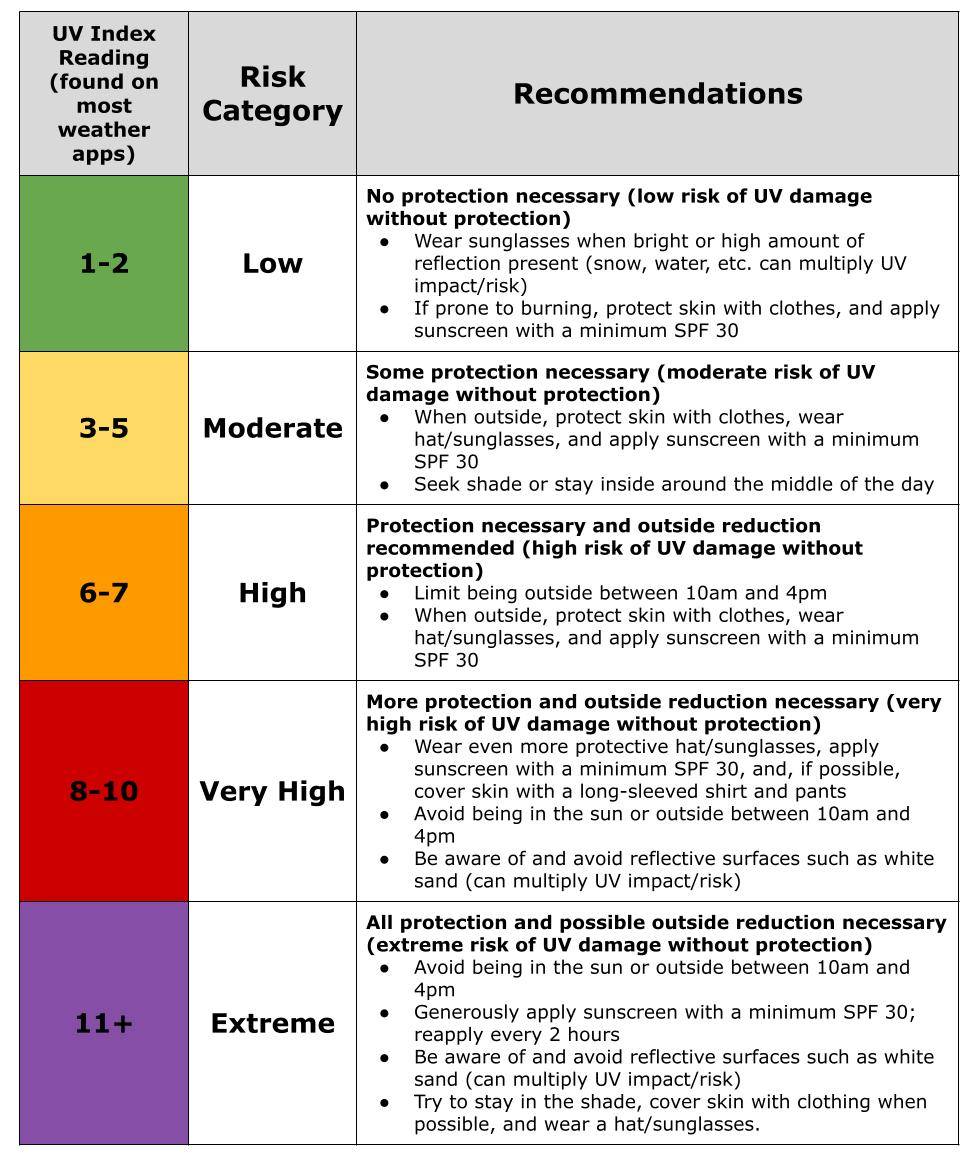
Summary of table:
-
Dermatologists recommend sun protection when the UV index is 3 and above
-
As levels approach 6 and above, it’s best to limit your time in the sun
Resource used for table: https://www.weather.gov/ilx/uv-index
ABCDE Method Assessment
Melanoma is the deadliest form of skin cancer. When detected early, melanoma is highly treatable. Know your skin. Perform a self-exam each month. You can even ask a partner or friend to look at your back and scalp. If you see any of these warning signs, show them to your provider right away.
By remembering your ABCDEs, you can evaluate your skin for possible development of melanoma. ABCDE is an acronym which stands for:
|
Moles/freckles are concerning if they have any of the following characteristics... |
|
|---|---|
|
Asymmetry: Has an asymmetrical appearance |
|
|
Borders: has blurry and/or jagged edges |
|
|
Color: has more than one color |
|
|
Diameter: has a diameter larger than a pencil eraser (6 mm or 1/4 inch) |
|
|
Evolution: has gone through changes in size, shape, or color |
[1692218674].jpg)
How to do a skin self-exam
Follow this link to a step-by-step skin self-exam guide:
https://www.aad.org/public/diseases/skin-cancer/find/check-skin
[1693604579].jpg)
Resources
Contrary to Popular Belief source: ASDS. (2023). Skin experts. Skin Cancer Myths. https://www.asds.net/skin-experts/skin-cancer/skin-cancer-myths
Fast Facts source: The Skin Cancer Foundation. (2023). Skin Cancer Facts & Statistics. https://www.skincancer.org/skin-cancer-information/skin-cancer-facts/?fbclid=IwAR3r4icfuXoOjTxPX_AaHG8qRosxKMzdmrBMdciB6TmZ1kGisMwLLRyP0OM
Fast Facts Image source: The Skin Cancer Foundation. (2023). Skin Cancer Awareness Toolkit. https://www.skincancer.org/get-involved/skin-cancer-awareness-month/toolkit/
General Risk Factors Image source: The Skin Cancer Foundation. (2023). Skin Cancer Awareness Toolkit. https://www.skincancer.org/get-involved/skin-cancer-awareness-month/toolkit/

